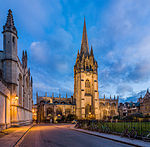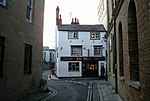Oriel Square tennis court
1923 disestablishments in the United KingdomBuildings and structures of the University of OxfordDefunct real tennis venuesFormer buildings and structures in OxfordOriel College, Oxford ... and 4 more
Sport at the University of OxfordSports venues in OxfordTennis venue stubsUse British English from February 2023
The Oriel Square tennis court was a real tennis court that was located in Oriel Square, central Oxford, England. The Liber Albus mentions the Oriel court being in Vinehall Lane in 1577.Charles I played tennis here with his nephew Prince Rupert in December 1642 and King Edward VII had his first tennis lesson here in 1859.The court survived until 1923, when it was used as a lecture hall by Oriel College, though it may have seen earlier use as a theatre. The site is now the location of Oriel College's Harris Building, used for student accommodation, a seminar room and lecture theatre.The only active court left in the city is the Merton Street tennis court.
Excerpt from the Wikipedia article Oriel Square tennis court (License: CC BY-SA 3.0, Authors).Oriel Square tennis court
Magpie Lane, Oxford City Centre
Geographical coordinates (GPS) Address Nearby Places Show on map
Geographical coordinates (GPS)
| Latitude | Longitude |
|---|---|
| N 51.75202 ° | E -1.25427 ° |
Address
Oriel College
Magpie Lane
OX1 4ES Oxford, City Centre
England, United Kingdom
Open on Google Maps









